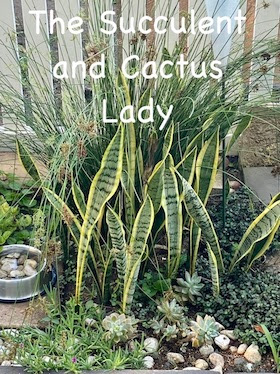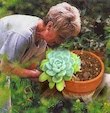Genus: Aloe (AL-oh)
Species: striatula (stree-AT-yew-luh)
From the wilds of South Africa comes this amazing species with upright stalks of 1" wide, dark green foliage. In warmer climates, the stalks can reach in excess of 3' tall. The larger stalks tend to arch outward with age due to excess weight...as do we. In early summer, the clumps are topped with amazing scapes of orange-yellow bells. This is one for the plant nut who likes to push the limits of hardiness.
Aloe striatula is a strong-growing climbing aloe whose native habitat is in mountain tops south of the Karoo region of South Africa. A tough and hardy plant, Aloe striatula is popular in gardens throughout the world. It can grow to a 6 feet tall shrub.
Aloe striatula gets its name from its distinguishing markings -- dark green stripes on its stems and leaf sheathes, in Latin "striatula" means "striped". Also known as the “Coral Aloe”, Aloe striatula is quite cold and heat tolerant. Its leaves are thin, dark green and strongly recurved, with small white teeth on their margins.
Aloe striatula is one of the hardiest aloes, and will tolerate much colder temperatures than most Aloes, including frost and even some snow, but it prefers full sun and well-drained soil. In the Eastern Cape it is often planted along the boundaries of kraals, as it naturally forms a well-shaped and hardy hedge. Like other climbing aloes, it can easily be propagated by cuttings (truncheons) as well as by seed.
The brilliant yellow inflorescence emerges in late fall through winter and rises above the foliage.
When planting in the garden you will need to provide Aloe striatula with a free-draining soil as it can be prone to attack from fungal infections if the roots become too wet. Dig in plenty of horticultural grit and sand to the soil of required but avoid planting in heavy soils or soils that are prone to water logging.
If suitable ground does not exist then consider planting into a pre-formed mound of free-draining soil, a raised bed or even a suitably sized container. For the container, use a good quality compost but with a 50:50 mix of horticultural grit and sand.
Although closest to the rare and unique Aloe commixta of Table Mountain, Aloe striatula is part of a whole group of related climbing aloes that grow throughout Southern Africa, the "Macrifoliae" Aloes. Other species in this group are: Aloe ciliaris, Aloe tenuior, Aloe gracilis, Aloe juddii, Aloe decumbens, and of course commixta and striatula itself.
.











